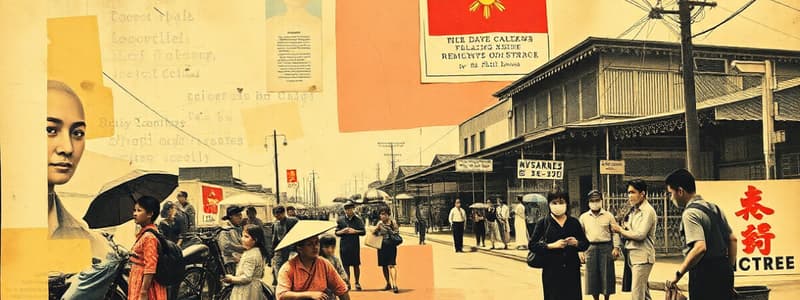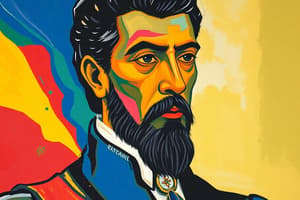Podcast
Questions and Answers
What does the name 'Rizal' signify?
What does the name 'Rizal' signify?
- Blue sky
- Old garden
- Red earth
- Green field or new pasture (correct)
Which philosopher is associated with the concept of the social contract?
Which philosopher is associated with the concept of the social contract?
- John Locke
- Thomas Hobbes
- Jean Jacques Rousseau (correct)
- Friedrich Nietzsche
What was the significance of the movement concerning the secularization of parishes?
What was the significance of the movement concerning the secularization of parishes?
- To control the migration of Chinese people
- To increase church attendance
- To promote English as the official language
- To stigmatize secular priests as political figures (correct)
What is the birthdate of Jose Rizal?
What is the birthdate of Jose Rizal?
Which secular priest officiated Jose Rizal's baptism?
Which secular priest officiated Jose Rizal's baptism?
What motto is associated with the ethos presented in the content?
What motto is associated with the ethos presented in the content?
Which activities were described as part of Rizal's experiences during his time in Ateneo?
Which activities were described as part of Rizal's experiences during his time in Ateneo?
What was the outcome of Rizal's diligence and study efforts at Ateneo?
What was the outcome of Rizal's diligence and study efforts at Ateneo?
Which of the following statements best captures the influence of Francisco de Paula Sanchez on Rizal?
Which of the following statements best captures the influence of Francisco de Paula Sanchez on Rizal?
How did Rizal's family respond to his request to stay in the Ateneo dormitory?
How did Rizal's family respond to his request to stay in the Ateneo dormitory?
Which poem did Rizal write when he was 15 years old?
Which poem did Rizal write when he was 15 years old?
What was Rizal's experience in the poetry contest he entered while studying at UST?
What was Rizal's experience in the poetry contest he entered while studying at UST?
What aspect of his childhood does Rizal express in the poem 'Un Receurdo a mi Pueblo'?
What aspect of his childhood does Rizal express in the poem 'Un Receurdo a mi Pueblo'?
Which poem is highly regarded as a gem in Philippine Literature in Spanish?
Which poem is highly regarded as a gem in Philippine Literature in Spanish?
What evidence exists regarding the authorship of 'Sa Aking mga Kabata'?
What evidence exists regarding the authorship of 'Sa Aking mga Kabata'?
What derogatory terms were used to describe Filipinos?
What derogatory terms were used to describe Filipinos?
Which event marked the rapid spread of education in the Philippines around 1860?
Which event marked the rapid spread of education in the Philippines around 1860?
At what age did Rizal write 'A la Juventud Filipina'?
At what age did Rizal write 'A la Juventud Filipina'?
Which social class emerged during the 19th century in the Philippines?
Which social class emerged during the 19th century in the Philippines?
What criticism is associated with 'Sa Aking mga Kabata'?
What criticism is associated with 'Sa Aking mga Kabata'?
When did Rizal first encounter the term 'Kalayaan'?
When did Rizal first encounter the term 'Kalayaan'?
What type of education did the Jesuits influence in the 19th century?
What type of education did the Jesuits influence in the 19th century?
Who authored the book that depicted Filipinos as unfit to learn Spanish?
Who authored the book that depicted Filipinos as unfit to learn Spanish?
Which group was said to have contributed to the beginnings of Natural Sciences in the Philippines?
Which group was said to have contributed to the beginnings of Natural Sciences in the Philippines?
Which elite group was part of the emerging middle class in the 19th century?
Which elite group was part of the emerging middle class in the 19th century?
What was a result of the 19th-century educational changes in the Philippines?
What was a result of the 19th-century educational changes in the Philippines?
What was the sentiment towards religion and its friars during this period?
What was the sentiment towards religion and its friars during this period?
What educational institution was transformed during this era?
What educational institution was transformed during this era?
What type of grades did Jose Villaclara achieve?
What type of grades did Jose Villaclara achieve?
What transformation did Jose experience during his time at Ateneo?
What transformation did Jose experience during his time at Ateneo?
Which of the following was NOT mentioned as a focus of Jose's studies?
Which of the following was NOT mentioned as a focus of Jose's studies?
What was the nature of the dorm life at Ateneo according to Jose?
What was the nature of the dorm life at Ateneo according to Jose?
What was Jose's experience with singing lessons?
What was Jose's experience with singing lessons?
Flashcards are hidden until you start studying
Study Notes
Filipinos in the 19th Century
- Filipinos faced discrimination, being referred to as "chonggos" (monkeys) or "bestias cargadas del oro" (beasts laden with gold).
- Some Spanish clergy, like Fr. Miguel Lucio Busmante, portrayed Filipinos as unfit for education and suitable only for manual labor.
- Fr. Gaspar de San Agustin's view of Filipinos as "created along with rattan" further exemplifies the prevailing prejudice against Filipinos.
- A middle class emerged in the 19th century, composed of Mestizo-Español (Spanish-Filipino), Principalia/Inquilino (local elites), and Mestizo-Chino (Chinese-Filipino).
- The 19th century witnessed the rise of the "middle class" associated with "urbanidad Española," which included fields like law, medicine, and theology.
- The "middle class" were drawn to liberal arts studies, eventually influencing the formation of the Filipino intelligentsia.
The Rise of Modern Education
- Rapid spread of education in the Philippines occurred around 1860.
- Filipinos learned to converse in the Spanish language.
- The return of the Jesuits in 1859 brought new ideas and methods to Philippine education.
- The Escuela Pia was transformed into the Ateneo Municipal de Manila.
- The Escuela Normal de Maestros was established, laying the foundation for humanistic education.
- The Jesuits introduced a system of education that made books widely accessible to Filipino students, fostering their enlightenment on human nature, government-people dynamics, and other vital topics.
- The Catholic practice of the day was deemed archaic and incompatible with modern ideologies.
- Religion and its friars were viewed as tools for maintaining the status quo.
Jose Rizal's Background
- Jose Protacio Mercado y Alonso Rizal was a renowned Filipino national hero.
- His name, Rizal, is derived from "ricial," meaning "green field" or "new pasture."
- Pepe was his official nickname, likely stemming from his given name, Jose, and the Spanish pronunciation of "P.P."
- Rizal was born on June 19, 1861, in Calamba, Laguna.
- His exceptional survival at birth, attributed to his oversized head, was attributed to the Virgin Mary, Our Lady of Peace and Safe Voyage.
- Rizal was baptized on June 22, 1861, by Rev. Rufino Collantes, a secular priest from Batangas.
Rizal's Early Literary Works
- "Un Recuerdo a mi Pueblo" (In Memory of my Town) was written when Rizal was 15 years old, marking his childhood.
- "A la Juventud Filipina" (To the Filipino Youth), written in 1879 when he was 18, is considered a gem of Philippine Literature in Spanish.
- This poem was submitted to a poetry contest organized by the Liceo Artistico Literario de Manila (Manila Lyceum of Art and Literature).
- Rizal won the first prize, a silver pen.
- "Sa Aking mga Kabata" (To My Fellow Youth), written in 1869, has been subject to debate.
- Its authenticity is questioned due to the lack of a manuscript in Rizal's handwriting.
- The poem uses "K" (commonwealth era spelling) and "Kalayaan," a term Rizal encountered in 1882, adding to its questionable origin.
Rizal's Educational Journey
- Rizal's mother, Teodora Alonzo, was his first teacher.
- Rizal had his first schooling at home, learning reading and writing.
- He was also tasked with running errands, fostering a sense of responsibility.
- Despite his early experiences, his later education became more focused on academics.
- Francisco de Paula Sanchez, a teacher at the Ateneo Municipal, inspired Rizal to excel in his studies.
- Inspired by Sanchez's example, Rizal consistently topped all subjects and received five medals at the end of his term at the Ateneo.
- Notable educational endeavors at Ateneo included:
- Philosophy and natural science with Fr. Jose Villaclara
- Painting with Agustin Saez
- Sculpture with Romualdo de Jesus
- Failed attempts at voice lessons, which he later abandoned.
Literary Influences and Early Reading Habits
- Rizal was influenced by many literary works, including "The Count of Monte Cristo" by Alexander Dumas and "Universal History" by Cesar Cantu.
Studying That Suits You
Use AI to generate personalized quizzes and flashcards to suit your learning preferences.




